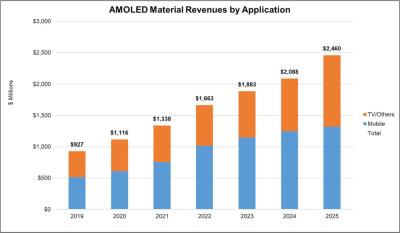OLED (Organic Light Emitting Diodes) is a flat light emitting technology, made by placing a series of organic thin films (usually carbon based) between two conductors. When an electrical current is applied, light is emitted. OLEDs are used to make displays and lighting panels. OLEDs today are widely used in TVs, smartphones, tablets, laptops and wearables.
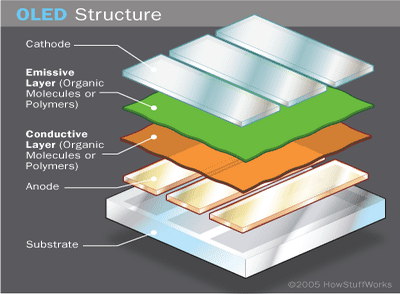
While OLED displays excel in color-contrast and efficiency compared to LCDs, they’ve also proven relatively hard to produce on a large scale. Current evaporation-based production techniques involve a lot of wasted material and risk of defects. OLEDs are also extremely sensitive to moisture and oxygen and therefore must be protected with a high performance encapsulating layer.
OLED ink-jet printing
Current OLED producing methods rely on evaporation processes, in which the organic materials are deposited onto a glass sheet through a thin metal stencil, also known as a "shadow mask. This process is problematic, as a significant amount of the material is wasted because it disperses all over the mask, in addition to inherent mask changes which expose the sheet to dust and compromise yields (OLEDs are by nature sensitive to contamination).
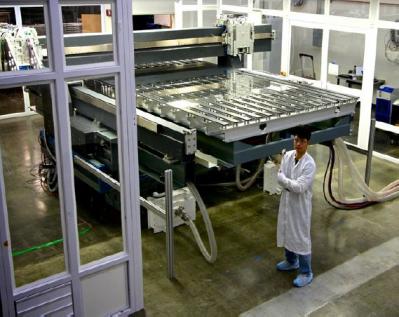
Inkjet OLED printing has the desirable ability to allow precision deposits without the use of a mask. It also produces less stray particles, thus boosting yields. These significant advantages make this technology interesting to many companies and virtually all OLED makers have active ink-jet printing development projects.
For many years, companies all over the world invested heavily in inkjet printing processes for OLED displays, but the process is not yet common, as printing OLED displays is a relatively challenging task, and soluble OLED materials are less effective than evaporable ones. Ink-Jet printing is also not able to reach the same high densities of evaporation OLED production, which limits its applications for large-area production (TV panels) and not small mobile, VR and wearable OLEDs.
Printed OLED panels on the market
One area in which inkjet printing is common in the OLED production process is the encapsulation layer deposition. Almost all OLEDs that adopt TFE encapsulation use inkjet printing to deposit the organic elements.
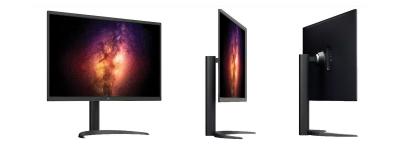
LG 32EP950 OLED monitor (31" 4K printed OLED panel by JOLED)
For actual OLED emitter layers deposition, currently the only company that commercially uses ink-jet printing is Japan's JOLED, who in 2021 started printing OLED display panels in its 5.5-Gen production line in Nomi, Ishikawa Prefecture, Japan.
The latest OLED ink jet news:
DSCC posts its latest outlook for the OLED materials market
DSCC posted an interesting post with its latest views and forecasts on the OLED material market. The company expects AMOLED stack material sales to grow at a 18% CAGR in the next five years, from $294 million in 2019 to $2.46 billion in 2024. Compared to its previous estimate, DSCC sees higher sales as demand for OLED TVs and OLEDs in the IT market (tablets and notebooks) is increasing.
DSCC also posted an analysis of LGD's new evo OLED material stack. Compared to LGD's "standard" WOLED stack, the evo adds an emitting green layer to improve the brightness by 20%. This of course adds an extra material cost to the panel price.
JOLED supplies its printed OLEDs for LG's upcoming 31.5-inch 4K monitor
A couple of days ago, LG Electronics announced its first OLED monitor, the 31.5-inch 4K UltraFine OLED Pro, model 32EP950. Today JOLED announced that LG's monitor uses the company's printed OLED panels.
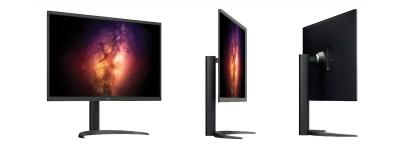
JOLED (Japan OLED) was established in August 2014 by Japan Display, Sony and Panasonic to produce OLED displays using inkjet printing technology. In December 2017 JOLED started commercial low-volume production of its 21.6" 4K OLED panels, at the company's pilot 4.5-Gen line.
TCL / CSoT shows its rollable AMOLED displays at CES 2021
In October 2020 TCL's CSoT demonstrated some new rollable OLED technologies, and today at CES the company published this nice video you see below that again demonstrates new rollable OLEDs:
TCL first shows a rollable smartphone, that uses a 7.8-inch AMOLED that rolls into a 6.7-inch one. The display features a bending radius of 3 mm and CSoT says it can withstand up to 100,000 sliding cycles.
Will TCL launch its first printed OLED products at CES 2021 next week?
TCL has been involved with OLED inkjet printing technologies for many years, and the company''s chairman and founder Li Dongsheng yesterday posted that the company will reveal its first printed OLED products next week. Li also uploaded the following video that showcases the company's inkjet printing technology:
This is somewhat surprising as it may be too early for TCL to actually launch inkjet printed OLEDs. TCL has been a long time believer in inkjet printing for OLED displays, and the company has established Juhua Printing in 2016 (together with Tianma and other collaborators) as an "open-innovation platform" to develop ink-jet printing of OLED panels. Last year TCL invested $187 million USD in Japan's inkjet printing developer and producer JOLED, and has also signed an agreement to jointly develop OLED TV printing technologies.
Notion Systems, MBraun and the Fraunhofer IAP develop a novel display industrial production process based on inkjet printing
Notion Systems, MBraun and the Fraunhofer Institute for Applied Polymer Research (Fraunhofer IAP) are co-developing new inkjet production technologies, aimed for the display market - specifically for OLED, QD and microdisplays.

The three partners are combining their respective competencies to present themselves together as a partnership supplier off all-in-one solutions. The Fraunhofer IAP is developing custom-made processes for display manufacturing with tailor-made inks. To achieve an industrial-scale best-in-class process solution, the parties are looking into all major pre-and post-processing steps, the substrate and the production equipment such as the inkjet print head.
JOLED and AERQ to integrate medium-sized OLED displays in aircraft cabins
Japan-based inkjet printed OLED JOLED announced a partnership with Germany-based AERQ to integrate medium-sized OLED displays in aircraft cabins.
AERQ, interestingly, is a joint venture between LG Electronics and Lufthansa Technik, founded in 2019. AERQ aims to introduce innovative technologies to the aviation industry, and the company provides a digital ecosystem for aircraft cabins that consists of an open IT platform, inseat system, and Cabin Digital Signage. AERQ has already been showing large-area OLED display for aerospace applications (using panels by LG Display).
NajingTech produces Quantum Dot Displays with Inkjet Technology from Notion Systems
This is a sponsored post by Notion Systems
Najing Technology Corporation Ltd., the leading Chinese manufacturer of quantum dot materials uses the Notion n.jet display systems for QD displays and light emitting diodes development and pilot production.
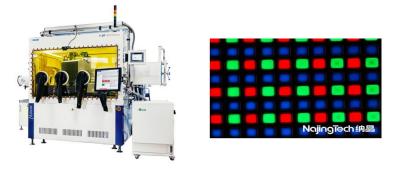
The n.jet display series prints functional layers in various steps of display production and for various display technologies. This includes rigid, flexible, OLED, QLED and LCD displays. In addition to its unparalleled precision, the platform complies with highest demands on process environment and process stability.
TCL to invest $6.8 billion, plans to start producing inkjet-printed OLED TVs in Guangzhou in 2024
According to reports from China, TCL says its CSOT OLED inkjet printing project is going well, and the company expects to start mass production at its 8.5-Gen Guangzhou T8 (owned by Huaxing Optoelectronics) production line in 2024.
Earlier this year the Guanghzhou development commission issued a report that says CSOT's investment in this R&D and production project will amount to 46 billion yuan ($6.8 billion USD), and the construction of the actual production line will be in 2021-2023.
Notion Systems and M.Braun announce a strategic partnership on OLED inkjet printing equipment
Notion Systems and M.Braun announced a strategic partnership in OLED processing equipment. The two companies will combine their best-in-class OLED production technology to improve the production process offers and enhance market access in Asia.
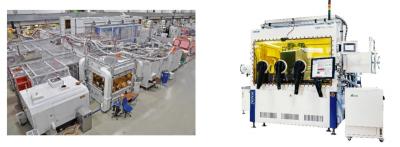
M.Braun is a developer of glove boxes, inert gas purification and automation solutions while Notion Systems is a leading developer of industrial inkjet-printing systems for functional materials, and both companies already enjoy the growing demand of OLED manufacturing in Asia.
BOE details its 55" 8K inkjet-printed OLED TV prototype
In December 2019 BOE unveiled a 55" 8K (160 PPI) OLED TV prototype produced by inkjet printing. The panel achieves a maximum brightness of 400 nits and a color gamut of 95% DCI-P3.
At SID Displayweek 2020, the company demonstrated this display and gave more details regarding its production process and display structure.
Pagination
- Previous page
- Page 5
- Next page
